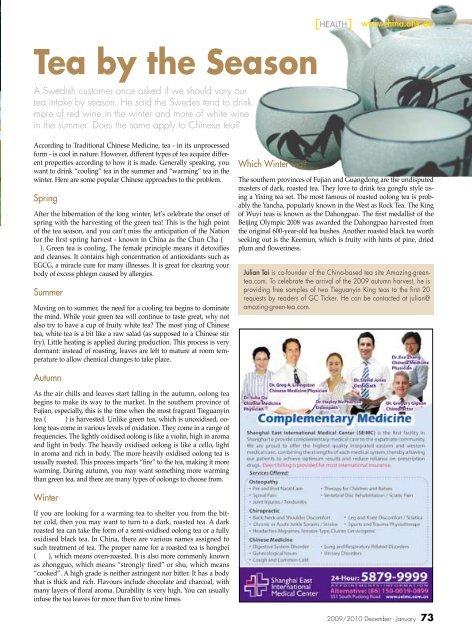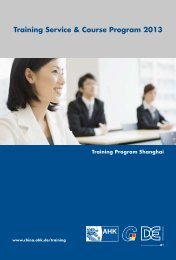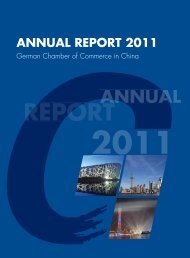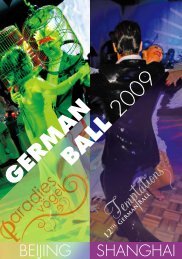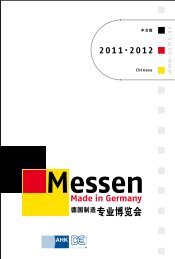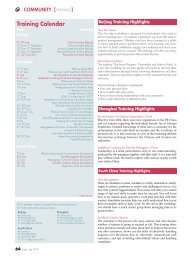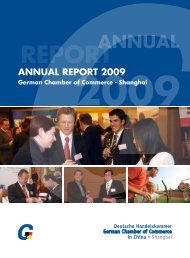Create successful ePaper yourself
Turn your PDF publications into a flip-book with our unique Google optimized e-Paper software.
Tea by the Season<br />
A Swedish customer once asked if we should vary our<br />
tea intake by season. He said the Swedes tend to drink<br />
more of red wine in the winter and more of white wine<br />
in the summer. Does the same apply to Chinese tea?<br />
According to Traditional Chinese Medicine, tea - in its unprocessed<br />
form - is cool in nature. However, different types of tea acquire different<br />
properties according to how it is made. Generally speaking, you<br />
want to drink “cooling” tea in the summer and “warming” tea in the<br />
winter. Here are some popular Chinese approaches to the problem.<br />
Spring<br />
After the hibernation of the long winter, let’s celebrate the onset of<br />
spring with the harvesting of the green tea! This is the high point<br />
of the tea season, and you can't miss the anticipation of the Nation<br />
for the first spring harvest - known in China as the Chun Cha (春<br />
茶). Green tea is cooling. The female principle means it detoxifies<br />
and cleanses. It contains high concentration of antioxidants such as<br />
EGCG, a miracle cure for many illnesses. It is great for clearing your<br />
body of excess phlegm caused by allergies.<br />
Summer<br />
Moving on to summer, the need for a cooling tea begins to dominate<br />
the mind. While your green tea will continue to taste great, why not<br />
also try to have a cup of fruity white tea? The most ying of Chinese<br />
tea, white tea is a bit like a raw salad (as supposed to a Chinese stir<br />
fry). Little heating is applied during production. This process is very<br />
dormant: instead of roasting, leaves are left to mature at room temperature<br />
to allow chemical changes to take place.<br />
Autumn<br />
As the air chills and leaves start falling in the autumn, oolong tea<br />
begins to make its way to the market. In the southern province of<br />
Fujian, especially, this is the time when the most fragrant Tieguanyin<br />
tea (铁观音) is harvested. Unlike green tea, which is unoxidised, oolong<br />
teas come in various levels of oxidation. They come in a range of<br />
frequencies. The lightly oxidised oolong is like a violin, high in aroma<br />
and light in body. The heavily oxidised oolong is like a cello, light<br />
in aroma and rich in body. The more heavily oxidised oolong tea is<br />
usually roasted. This process imparts “fire” to the tea, making it more<br />
warming. During autumn, you may want something more warming<br />
than green tea, and there are many types of oolongs to choose from.<br />
Winter<br />
If you are looking for a warming tea to shelter you from the bitter<br />
cold, then you may want to turn to a dark, roasted tea. A dark<br />
roasted tea can take the form of a semi-oxidised oolong tea or a fully<br />
oxidised black tea. In China, there are various names assigned to<br />
such treatment of tea. The proper name for a roasted tea is hongbei<br />
(烘焙), which means oven-roasted. It is also more commonly known<br />
as zhongguo, which means “strongly fired” or shu, which means<br />
“cooked”. A high grade is neither astringent nor bitter. It has a body<br />
that is thick and rich. Flavours include chocolate and charcoal, with<br />
many layers of floral aroma. Durability is very high. You can usually<br />
infuse the tea leaves for more than five to nine times.<br />
Which Winter Tea?<br />
HEALTH<br />
www.china.ahk.de<br />
The southern provinces of Fujian and Guangdong are the undisputed<br />
masters of dark, roasted tea. They love to drink tea gongfu style using<br />
a Yixing tea set. The most famous of roasted oolong tea is probably<br />
the Yancha, popularly known in the West as Rock Tea. The King<br />
of Wuyi teas is known as the Dahongpao. The first medallist of the<br />
Beijing Olympic 2008 was awarded the Dahongpao harvested from<br />
the original 600-year-old tea bushes. Another roasted black tea worth<br />
seeking out is the Keemun, which is fruity with hints of pine, dried<br />
plum and floweriness.<br />
Julian Tai is co-founder of the China-based tea site Amazing-greentea.com.<br />
To celebrate the arrival of the 2009 autumn harvest, he is<br />
providing free samples of two Tieguanyin King teas to the first 20<br />
requests by readers of GC Ticker. He can be contacted at julian@<br />
amazing-green-tea.com.<br />
2009/2010 December - January 73


